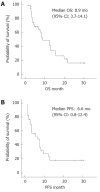Efficacy of hepatic arterial infusion chemotherapy in advanced hepatocellular carcinoma
- PMID: 22807613
- PMCID: PMC3396196
- DOI: 10.3748/wjg.v18.i26.3426
Efficacy of hepatic arterial infusion chemotherapy in advanced hepatocellular carcinoma
Abstract
Aim: To investigate the efficacy of hepatic arterial infusion chemotherapy (HAIC) using floxuridine (FUDR) in patients with advanced hepatocellular carcinoma (HCC) confined to the liver.
Methods: Thirty-four patients who had advanced HCC with unresectability or unsuccessful previous therapy in the absence of extrahepatic metastasis were treated with intra-arterial FUDR chemotherapy at our hospital between March 2005 and May 2008. Among the 34 patients, 9 patients were classified as Child class C, and 18 patients had portal vein tumor thrombus (PVTT). One course of chemotherapy consisted of continuous infusion of FUDR (0.3 mg/kg during day 1-14) and dexamethasone (10 mg on day 1, 4, 7 and 11), and this treatment was repeated every 28 d.
Results: Two patients (5.9%) displayed a complete response, and 12 patients (35.3%) had a partial response. The tumor control rate was 61.8%. The median overall survival times were 15.3 mo, 12.4 mo and 4.3 mo for the patients who were classified as Child class A, Child class B and Child class C, respectively (P = 0.0392). The progression-free survival was 12.9 mo, 7.7 mo and 2.6 mo for the patients who were classified as Child class A, Child class B and Child class C, respectively (P = 0.0443). The cumulative survival differed significantly according to the Child-Pugh classification and the presence of PVTT. In addition to hepatic reserve capacity and PVTT, the extent of HCC was an independent factor in determining a poor prognosis. The most common adverse reactions to HAIC were mucositis, diarrhea and peptic ulcer disease, but most of these complications were improved by medical treatment and/or a delay of HAIC.
Conclusion: The present study demonstrates that intra-arterial FUDR chemotherapy is a safe and effective treatment for advanced HCC that is recalcitrant to other therapeutic modalities, even in patients with advanced cirrhosis.
Keywords: Advanced hepatocellular carcinoma; Child-Pugh classification; Floxuridine; Hepatic arterial infusion chemotherapy; Portal vein tumor thrombus.
Figures



Similar articles
-
Hepatic arterial infusion chemotherapy for advanced hepatocellular carcinoma with portal vein tumor thrombosis: analysis of 48 cases.Cancer. 2002 Aug 1;95(3):588-95. doi: 10.1002/cncr.10694. Cancer. 2002. PMID: 12209752 Clinical Trial.
-
Sorafenib and hepatic arterial infusion chemotherapy for advanced hepatocellular carcinoma with portal vein tumor thrombus.Anticancer Res. 2015 Apr;35(4):2269-77. Anticancer Res. 2015. PMID: 25862889
-
Hepatic artery infusion chemotherapy combined with camrelizumab plus rivoceranib for hepatocellular carcinoma with portal vein tumor thrombosis: a multicenter propensity score-matching analysis.Hepatol Int. 2024 Aug;18(4):1286-1298. doi: 10.1007/s12072-024-10672-8. Epub 2024 May 8. Hepatol Int. 2024. PMID: 38717693 Free PMC article.
-
Systematic review of hepatic arterial infusion chemotherapy versus sorafenib in patients with hepatocellular carcinoma with portal vein tumor thrombosis.J Gastroenterol Hepatol. 2020 Aug;35(8):1277-1287. doi: 10.1111/jgh.15010. Epub 2020 Mar 3. J Gastroenterol Hepatol. 2020. PMID: 32052876
-
Sorafenib versus hepatic arterial infusion chemotherapy for advanced hepatocellular carcinoma: a systematic review and meta-analysis.Jpn J Clin Oncol. 2019 Sep 1;49(9):845-855. doi: 10.1093/jjco/hyz069. Jpn J Clin Oncol. 2019. PMID: 31063184
Cited by
-
MBP-11901 Inhibits Tumor Growth of Hepatocellular Carcinoma through Multitargeted Inhibition of Receptor Tyrosine Kinases.Cancers (Basel). 2022 Apr 14;14(8):1994. doi: 10.3390/cancers14081994. Cancers (Basel). 2022. PMID: 35454900 Free PMC article.
-
Feasibility of Hepatic Artery Infusion Chemotherapy for Colorectal Liver Metastasis in an Indian Setting.Indian J Surg Oncol. 2024 May;15(Suppl 2):275-280. doi: 10.1007/s13193-023-01871-0. Epub 2023 Dec 29. Indian J Surg Oncol. 2024. PMID: 38817996 Free PMC article.
-
Chlorogenic acid enhances the effects of 5-fluorouracil in human hepatocellular carcinoma cells through the inhibition of extracellular signal-regulated kinases.Anticancer Drugs. 2015 Jun;26(5):540-6. doi: 10.1097/CAD.0000000000000218. Anticancer Drugs. 2015. PMID: 25714249 Free PMC article.
-
Hepatic arterial infusion chemotherapy in hepatocellular carcinoma with portal vein tumor thrombosis.World J Gastroenterol. 2013 Aug 7;19(29):4679-88. doi: 10.3748/wjg.v19.i29.4679. World J Gastroenterol. 2013. PMID: 23922465 Free PMC article.
-
Diwu Yanggan capsule inhibits the occurrence and development of liver cancer in the Solt-Farber rat model by regulating the Ras/Raf/Mek/Erk signaling pathway.Am J Transl Res. 2018 Nov 15;10(11):3797-3805. eCollection 2018. Am J Transl Res. 2018. PMID: 30662630 Free PMC article.
References
-
- Parkin DM, Bray F, Ferlay J, Pisani P. Estimating the world cancer burden: Globocan 2000. Int J Cancer. 2001;94:153–156. - PubMed
-
- Lee JS. Advances in the treatment of hepatocellular carcinoma. Korean J Med. 2009;77:290–297.
-
- Makuuchi M, Hasegawa H, Yamazaki S. Ultrasonically guided subsegmentectomy. Surg Gynecol Obstet. 1985;161:346–350. - PubMed
-
- Ohtomo K, Furui S, Kokubo T, Yamauchi T, Itai Y, Yashiro N, Iio M. Transcatheter arterial embolization (TAE) in treatment for hepatoma--analysis of three-year survivors. Radiat Med. 1985;3:176–180. - PubMed
Publication types
MeSH terms
Substances
LinkOut - more resources
Full Text Sources
Medical

